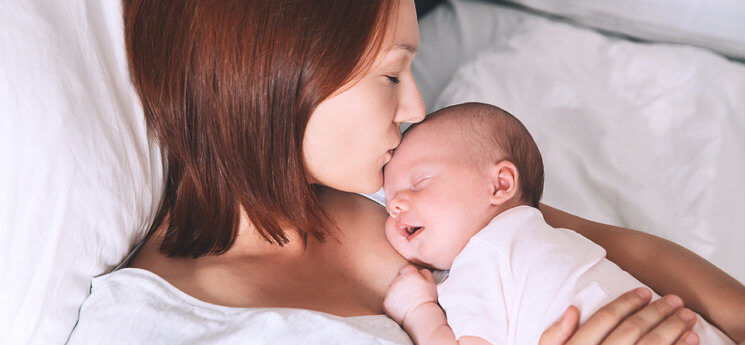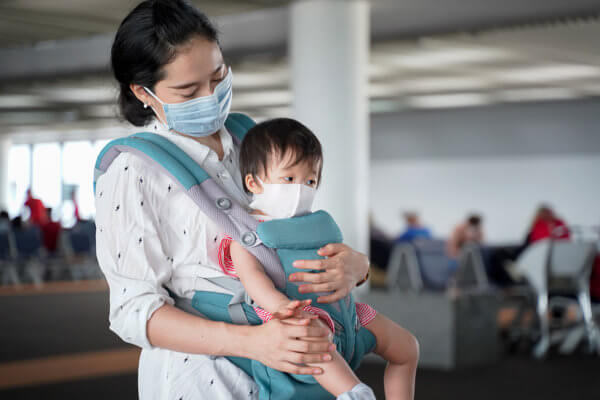Just a few decades ago, families lived in tight communities where new moms learned their parenting skills from their own mothers. In the 21st century, however, many of us live far away from our moms, aunts, sisters and grandmas—the traditional teachers of vital newborn skills like diaper changing, nail clipping and baby burping. “With families being separated, many new parents have had no experience with a newborn until they bring their own baby home,” says Fatima S. Khan, MD, FAAP, chair of pediatrics at Rush-Copley Medical Center in Aurora, Ill., and an assistant professor of pediatrics at Rush Medical College in Chicago, who teaches baby how-to classes to expectant parents. Khan highly recommends that all expectant parents take a “newborn 101” class well before their due date to familiarize themselves with newborn needs.
Even if you did attend a parenting class at your hospital or birthing center, once you actually have your little bundle in your arms, you may forget everything you were taught. Don’t fret—we’re here to help! Brush up on these skills now, and you’ll feel more confident about caring for your newborn in those first crazy weeks at home.
By week six, our experts guarantee, you’ll feel like an old pro. “Although you may have anxieties when you bring your baby home, do try to enjoy this magical time,” advises Alan Greene, MD, a clinical professor of pediatrics at the Stanford University School of Medicine. “Thankfully, this brand-new adventure has worked out very well throughout human history.”
START THE GUIDE
Newborn bathing
In those first weeks home, sponge bathing with a damp washcloth and baby soap is advised until the umbilical cord falls off and the navel (and circumcision) heals. When your baby is ready for “real” baths (this could be anywhere from one to three weeks, depending on the baby), choose an infant tub with contoured sides, which will help keep the baby from sliding around.
Fill the tub with no more than 3 inches of warm—never hot!—water; then place a clean washcloth, unscented baby soap/shampoo, towels, a diaper and clothes next to the bathtub. “Before you put your baby in the water, make sure you have everything you need within reach,” stresses Khan. “Never leave your baby by himself for anything!”
When bathing, always remember to cup your hands over baby’s forehead to keep suds away from his eyes when rinsing out shampoo (you can use a plastic cup for this). Don’t bathe for too long. Then immediately wrap him in a dry towel to prevent a chill. “Bathing does take some practice,” Khan says. “The more adult hands, the better when you’re learning.”
Infants need only two to three baths a week during their first year; more than that may dry out their velvety-soft skin. According to Khan, there is new research that says daily baths are okay—but you should apply moisturizer very liberally and not apply soap to baby’s entire body.
PRO-DIAPERING TIPS
Babies need a diaper change 10 to 12 times daily, so all parents manage to get the hang of this pretty quickly! Here are some tips that will have you diapering like a pro ASAP:
- Have everything you need—diaper, wipes, cream—in arm’s reach. Babies are wiggly and can fall if you’re not right next to them.
- Use the appropriate diaper size. Too big and you’ll be cleaning more than your baby’s tush!
- Using a washcloth or baby wipe, clean your baby from the front to the back (especially girls) to prevent the spread of bacteria from the rectum that can cause urinary tract infections. For boys, place a clean diaper over the penis while cleaning him. (Exposure to air often causes little boys to urinate—all over the changing table, the walls and you!)
- To prevent diaper rash (red, puffy and tender skin in the buttocks, thighs and genital area), change your baby immediately after a bowel movement. After cleaning and drying completely, apply a barrier ointment to prevent or heal a rash. Our experts recommend products containing zinc oxide.
- Never dab a baby’s bottom with powder that contains talc, which can harm a baby’s lungs if inhaled.
- Call your doctor if a diaper rash doesn’t heal in several days, if pus develops or if it extends beyond the diaper area.
- If you opt for cloth diapers, eschew safety pins and use new parent-friendly varieties with built-in Velcro tabs, which you can adjust as your baby grows.
- Let your baby go native for a bit of time every day to give sensitive skin in the diaper area a chance to air out.
- Wash your hands after every change to prevent the spread of germs.
DEALING WITH CRADLE CAP
Contending with cradle cap
These patchy, flaky scales on your baby’s scalp may look alarming, but there’s really nothing to worry about. Cradle cap doesn’t generally need medical treatment because it clears up on its own in a few months. In the meantime, you can wash and gently brush your baby’s scalp daily to help loosen the scales. If the scales don’t loosen easily, rub petroleum jelly or a few drops of baby oil into the scalp, and let it soak for a few minutes. Then shampoo and brush as you usually do. Just don’t leave the oil or jelly in the hair because it may worsen the cradle cap.
“A new layer of skin is growing faster than the old skin can fall off,” explains Alan Greene, MD, whose latest book is Feeding Baby Green (Jossey-Bass, 2009; see page TK for a review). “Cradle cap is not a disease—it’s healthy skin!” Greene doesn’t recommend using cortisone or other medicated creams, since they can slow down scalp growth. Contact your pediatrician if the patches of flaky skin spread to the baby’s body or face.
TENDING TO THE UMBILICAL CORD
Tending to the umbilical cord
While you’re pregnant, this cord supplies nutrients and oxygen to your developing baby. After birth, the umbilical cord is no longer necessary and, hence, is snipped off, leaving behind a short stump that doesn’t contain any nerves (so your baby feels nothing during this birth rite). Your job is to keep the stump clean and dry until it falls off naturally in one to three weeks.
“Using a Q-tip, just wash the stump and surrounding area with baby soap and water, not alcohol,” says Theresa Grover, MD, medical director at the Children’s Hospital Neonatal Intensive Care Unit in Denver, Colo. “The stump falls off sooner if you use just water.” For decades the daily use of alcohol was advised for cord care, but now the AAP recommends using only water because studies haven’t shown any benefit to using alcohol over water.
To prevent irritation, fold diapers down below the healing stump area or buy newborn diapers with a cutout at the cord area. If the area around the cord becomes red or swollen, or bleeds or oozes pus, call your pediatrician.
CARING FOR A CIRCUMCISION
Caring for a circumcision
After your son’s foreskin has been removed, thin gauze will cover the site and stay in place for one to two days before falling off on its own, or if a Plastibell type of circumcision has been performed, a white string will be in place that will fall off in about a week.
After that, keep the area clean with a gentle baby soap and water (experts advise against using diaper wipes). Dab a little petroleum jelly on the circumcision site each time you change your son’s diaper to prevent friction. “You may see a clear yellow discharge,” says Grover. “That’s normal—as long as it doesn’t look like pus.” The penis tip should heal in seven to ten days. Call your pediatrician if the circumcision site is swollen or increasingly red, or discharges pus.
CAREFUL NAIL CLIPPING
Careful nail clipping
If you’re nervous about clipping your baby’s skin and causing harm, we have one word for you: file! “It’s much safer,” says Khan. Your baby’s nails grow very quickly and you’ll need to file the fingernails about once a week to keep him from scratching himself. (Toenails grow more slowly and require filing only once or twice a month.)
When your baby is 2 months old, you can use safety scissors to shorten fingernails and toenails. Experts recommend that you avoid using mittens since your baby needs touch to learn about his environment.
HOW TO SWADDLE
Supportive swaddling
If your baby is fussy, some nurturing techniques can be effective in soothing her. The first is swaddling (wrapping your baby tightly in a blanket), which gives newborns a sense of security and comfort. Here’s how to do it:
- Spread out a receiving blanket, with one corner folded over.
- Lay your baby face up on the blanket with her head above the folded corner.
- Wrap the left corner over her body and tuck it under her right arm and beneath her back.
- Bring the bottom corner over your baby’s feet and pull it toward her head, folding the blanket down if it gets close to her face.
- Wrap the right corner around and tuck it under her back on the left side, leaving only her neck and head exposed.
Another effective soothing technique is “kangaroo care,” in which a mother places a baby wearing only a diaper directly on her chest under her shirt or baby blanket. Studies have shown that the skin-to-skin aspect of kangaroo care can help regulate a baby’s breathing, heart rate and body temperature; encourage sleep and weight gain; and reduce infections in both preemies and full-term babies. When you “kangaroo,” your baby will usually snuggle into your breast and fall soundly asleep in minutes.
PACIFIERS. GOOD OR BAD?
Positive pacifying
Once considered a bit taboo because they were thought to interfere with breastfeeding, pacifiers are now recommended by the AAP for soothing a baby to sleep. Studies have shown that pacifier use may help prevent sudden infant death syndrome (SIDS) in infants up to 1 year of age, the period when a baby’s need for suckling is the highest (and the peak age for SIDS risk). After age 1, pacifier use may be linked to dental problems, such as front teeth that slant outward.
“In my experience, babies have no trouble going back and forth between breastfeeding, bottle feeding and pacifier use,” assures Grover. Choose a one-piece (two pieces pose a choking hazard if they break), dishwasher-safe pacifier and replace it often. Greene recommends pacifiers made without bisphenol A (such as those made by BornFree).
BURPING
Basic burping
Infants swallow air when they’re feeding—and this can make them gassy and cranky. Burping your baby after every 2 to 3 ounces (via bottle) or when you switch breasts during breastfeeding can prevent discomfort caused by swallowed air. There are three positions that work well for burping:
- Hold your baby upright with her head lying on your shoulder, and gently pat her back.
- Lay your baby on your lap, with her head higher than her chest, and pat her back gently.
- Sit your baby in your lap, supporting your baby’s head and chest with one hand while patting her back with the other.
“It usually takes about 30 seconds for a baby to burp,” says Grover. “If she doesn’t, don’t sit there trying for five minutes—sometimes a baby just doesn’t need to!” And if your baby spits up breast milk or formula every time you burp her, relax.
It’s common and perfectly normal—and may last till she’s 6 to 12 months old (or until she starts eating solids). In the meantime, you may want to place a clean towel on your shoulder or lap to protect your clothes.




